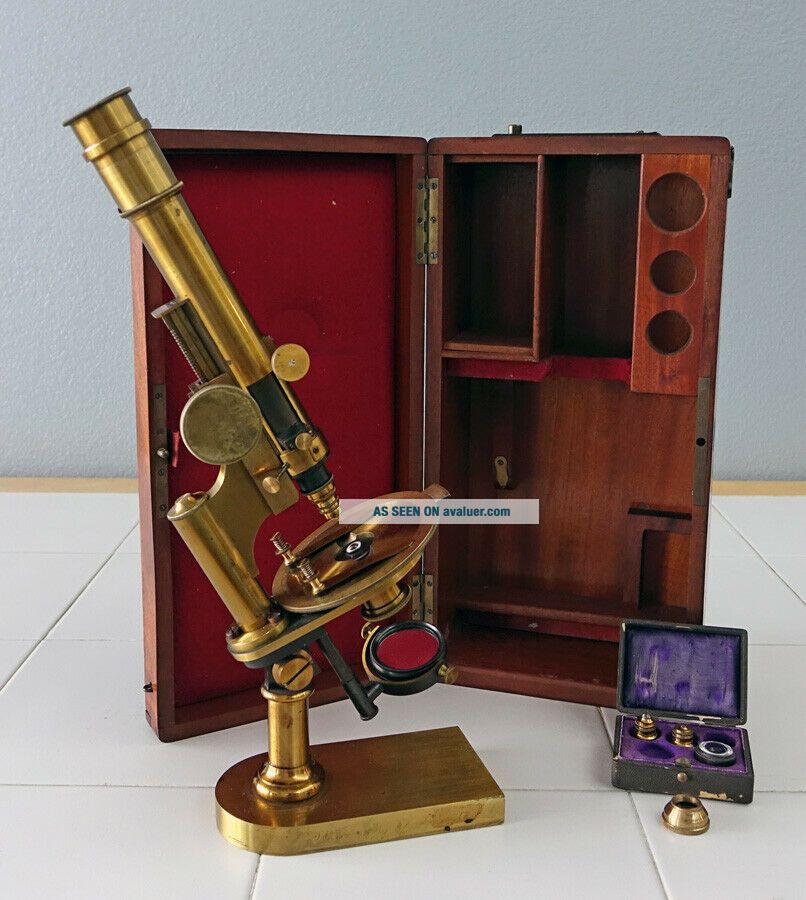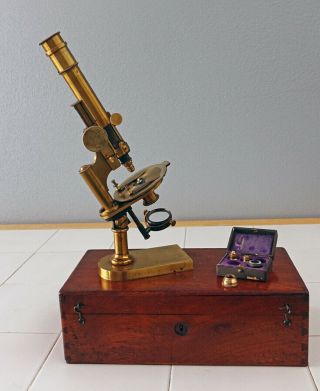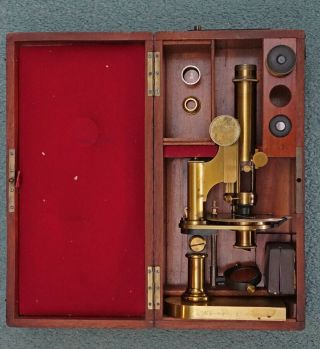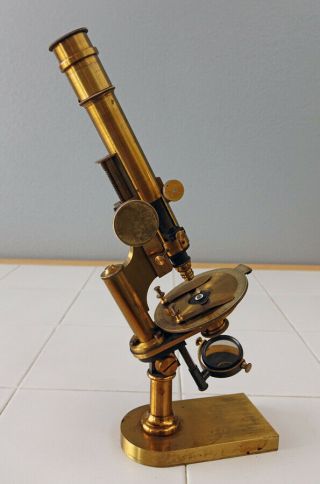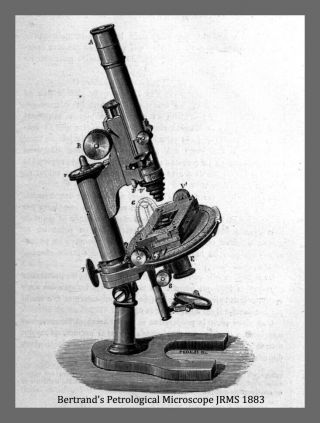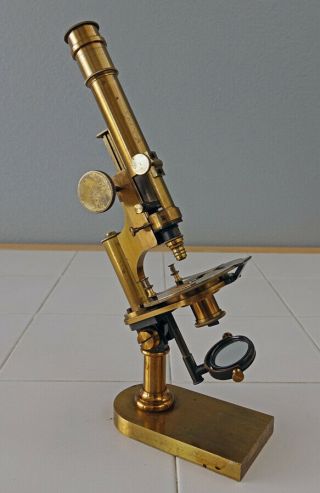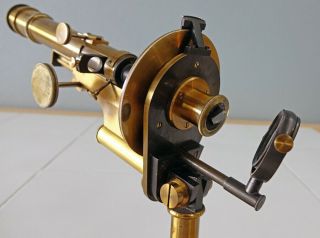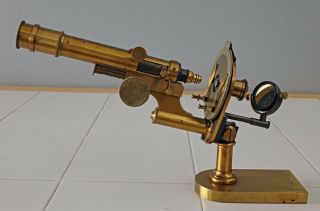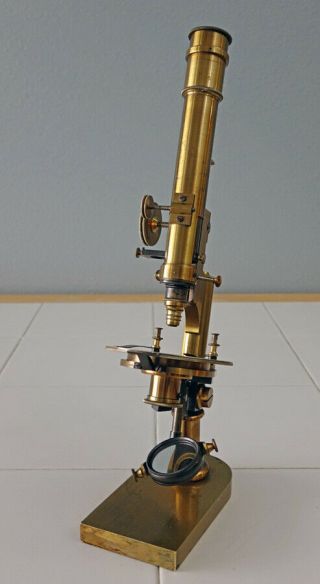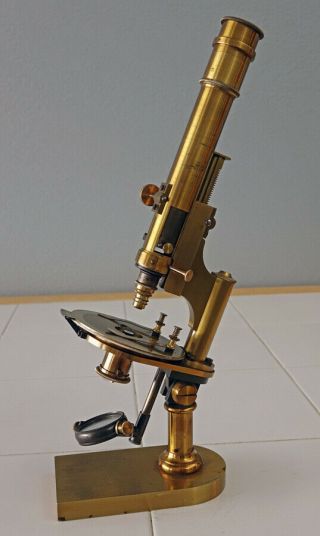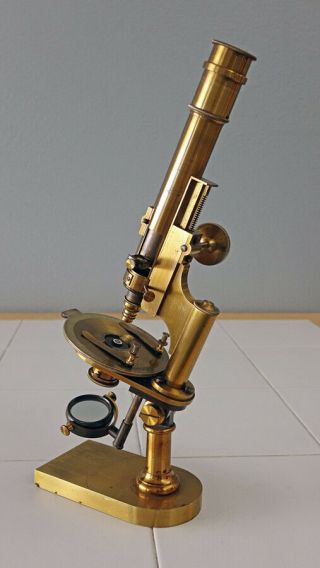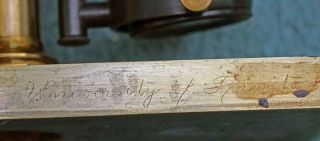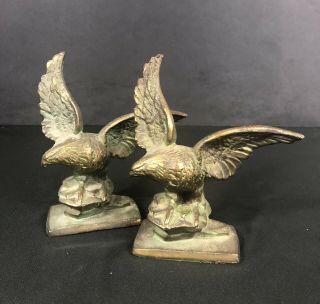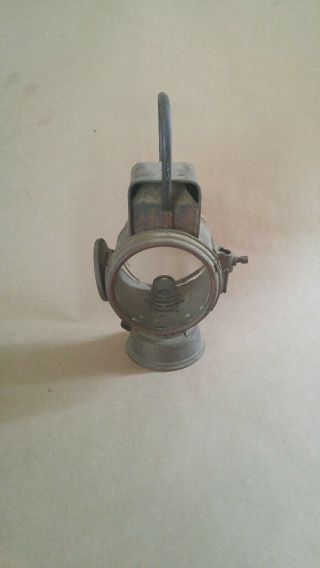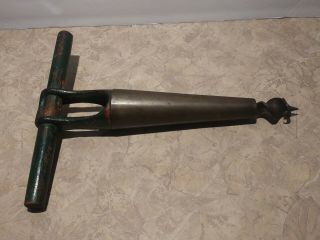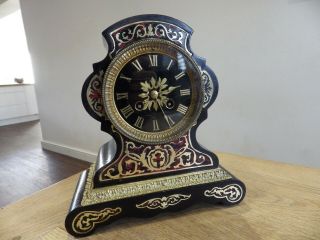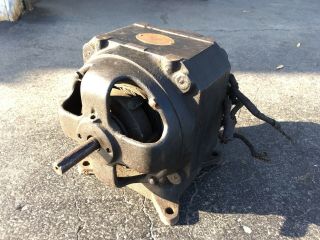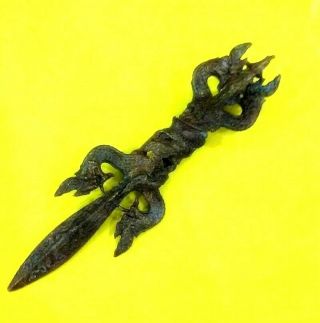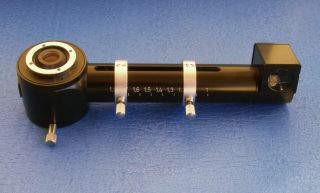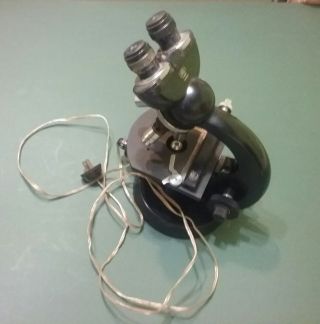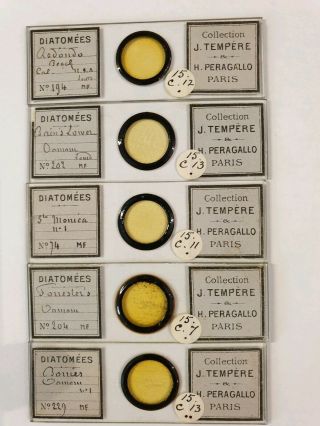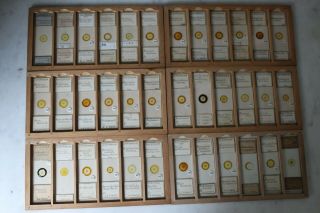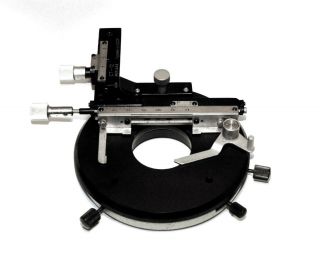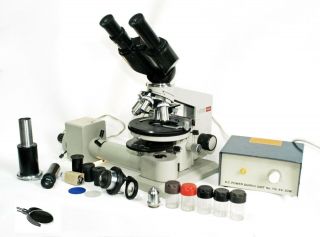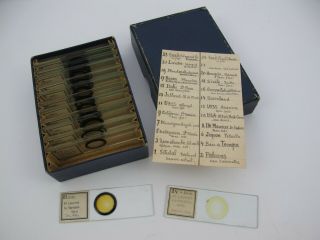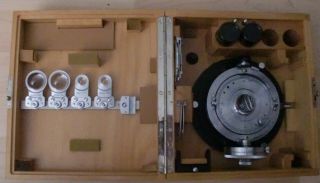EMILE BERTRAND PARIS ANTIQUE BRASS VERY EARLY PETROGRAPHIC POLARIZING MICROSCOPE
Item History & Price
EMILE BERTRAND PARIS ANTIQUE BRASS VERY EARLY PETROGRAPHIC POLARIZING (POL) MICROSCOPE�...� CIRCA 1878
You are invited to purchase an historically important very early petrographic polarizing microscope that was manufactured by Emile Bertrand of Paris in the latter part of the 19th Century. Included with the microscope is a set of optics (3 objective lenses + 2 condenser lenses) and a non-RMS to RMS objective adapter in a supplemental case along with a clamshell Mahogany wood case that houses the instrument and its optical accessories.
Emile Bertrand is perhaps best known for his invention of the Bertrand Lens that was named after him and is used in petrographic polarizing microscopes to create interference figures to help in the identification of minerals in thin section. Bertrand is also credited with making a few very early polarizing microscopes and was very instrumental in pioneering the use of this specialty microscope type in the fields of geology and mineralogy.
NOTE: For more on the history of Emile Bertrand and his microscopes, please see below.
This instrument is unsigned and does not bear a typical serial number. However, our research indicates that it was made by Emile Bertrand in Paris around the year 1878. It very closely matches Bertrand’s Petrological Microscope that was described and illustrated in the Journal of the Royal Microscopical Society Series II Volume III in 1883 pages 413 to 415. Included with this listing is an illustration of this microscope model extracted from my personal copy of the Journal article. It is included for comparison with the instrument featured here. The similarities to the listed microscope are readily apparent, but with some relatively minor differences/variations.
Further research shows that the featured instrument appears to be a transitional model between Bertrand’s first petrological microscope that was quite simple in design and function and his much larger and more elaborate “Grand” petrographic microscope model that was featured in the above noted Journal article. Both of these models are shown in black & white photographs in the following publication from 2012: “Travaux Du Comite Francais D’Histoire De La Geologie, La Microscope polarisant a l’assaut des montagnes” (Idomatic English translation: “Works Of The French History Committee of Geology” subtitled “The Polarizing Microscope Storms the Mountains”) by Jacques Touret (copy available on the internet). If you access this article via Google, please note Figure 3 that shows Bertrand’s first petrographic microscope model and Figure 4 that shows his later “Grand” model that was also illustrated in the 1883 JRMS article. Note how the featured instrument has the rectangular-half oval base of Bertrand’s first model along with many of the more complex body tube features of the latter Grand model microscope.
As Bertrand made very few petrographic polarizing microscopes during his career along with the historical importance of his pioneering efforts in petrographic microscope design related to mineralogy and geology, this super rare petrographic polarizing microscope model will be a very valued addition to any microscope collection that has a focus on the polarizing petrographic microscope. As most serious collectors are aware, rare instruments like this do not appear on the scene too often. Don’t miss this opportunity to add this historically significant instrument to your collection.
PROVENANCE:
This microscope came to us via a public auction of various antiques that was held in Toronto, Canada. Engraved lightly into the right side of the microscope base are the words, “University of Toronto” (see image). This leads us to believe that this instrument may have, at one time, been held in a microscope collection associated with that institution. Further efforts to ascertain more information about its history since its manufacture were unsuccessful.
DETAILED DESCRIPTION:
This microscope is built upon a very heavy part rectangular part half-oval shaped base of lacquered brass. The dimensions of the base are 150mm long by 80mm wide. The base is lead weighted. Rising from the rear of the base is a cylindrical pillar that rises to a compass joint. This joint supports the rest of the microscope, including the limb, the stage, the body tube and the substage condenser/polarizer/illumination assembly. The compass joint allows the microscope to be tilted at any angle from the vertical to the horizontal to allow for the comfortable viewing of specimen slides that are mounted atop the stage.
Coarse focus is by horizontal rack and pinion controlled by a single oversized brass milled head found on the right side of the limb. There is no fine adjustment mechanism associated with this instrument and there is no conventional drawtube.
The microscope is equipped with a 100 mm diameter, rotatable circular brass stage. The stage circumference is graduated in single degrees with every 10th degree line numbered allowing one to read the stage orientation within 0.1 degree. At the front of the stage is an engraved rectangular brass plate that allows the position of the stage to be set and read by the user. There is a pair of slide clips mounted atop the stage. The slide clips are spring loaded.
One unique feature of this stage is a pair of recessed channels found on either side of the 25mm diameter central aperture. This allows the user to insert his fingers into the slots so as to install or remove a mounted condenser lens that fits into the top of a brass cylinder found directly under the stage. Two (2) different condenser lenses are provided with the instrument. When not in use on the microscope, these condenser lenses are stored in a supplemental case that is also used to house the microscope objectives (see accompanying images).
Below the stage is a brass cylinder that is affixed to the underside of the stage mounting – the same brass cylinder that houses the condensers. Inserted into the lower end of this cylinder is a brass mounted Nicol prism polarizer assembly. The Nicol prism is mounted in cork. A small brass set screw is provided to hold the polarizer firmly in place in a designated slot on the side of the brass cylinder.
Under the polarizer is a yoke-mounted 38mm diameter plano-concave mirror that is mounted on a vertical bar that is attached to the underside of the stage near the compass joint. The mirror can be moved up or down along the bar and the entire mirror assembly can be moved from right to left in order to provide optimal illumination to the stage.
The body tube of this microscope is relatively complex with several special features. At the top of the body tube is a brass ocular holder with a single notch at the top and a single brass pin at its lower edge (see image). The upper notch is designed to accept a standard eyepiece with a set pin likely with a cross hair installed. NOTE: No original eyepieces came with this microscope. We have included two (2) modern substitute eyepieces to complete the system, but these are without set pins or cross hairs.
Fitting over the ocular holder and over a suitable eyepiece in the ocular holder, is a brass mounted eyepiece-type Nicol prism analyzer (included) that has a small slot at its base. This eyepiece-type analyzer fits over the ocular holder at the upper end of the body tube and over the brass pin at the base of the ocular holder (see image). This eyepiece analyzer contains a Nicol prism mounted in cork along with a clear glass cover at the top. It does not include nor was it apparently designed to include a magnifying lens of any type. Thus, the analyzer was designed to be used in conjunction with a properly designed eyepiece that was recessed into the ocular holder with the analyzer in its brass holder installed over it to provide properly magnified views of thin mineral specimens.
At the lower end of the body tube is a 15mm diameter non-RMS objective holder with male threads. A set of three (3) different non-RMS multi-part objective lenses with female threads are provided with this microscope. These objectives are unmarked as to powers or manufacturer, but they very closely resemble those made by Nachet of Paris. Each of these objectives consists of several elements (often called “button lenses”) that can be removed (unscrewed) to provide lower magnifying powers. When not in use on the microscope, these objectives are stored in felt-lined slots in the supplemental case that comes with the microscope. Note: This case looks much like the objective cases that Nachet supplied with his microscopes. Also included with these 3 objectives is a brass non-RMS to RMS objective adapter that can be used to equip the microscope with RMS objectives (RMS objectives not included). Immediately above the objective holder are two (2) brass milled heads that permit the centering of objectives in the optical path.
The lower end of the body tube above the objective holder is slotted on both sides and accommodates an internal brass cylinder with a slider slot on the lower end. The brass cylinder can be moved up or down within the body tube by rack and pinion as it is controlled by a single brass milled head found on the right side of the microscope. Inserted into the slot is a slider with a lens on one side and an open aperture on the other. According to the description of this microscope found in the aforementioned 1883 Journal article this slider (identified with the letter “L” in the accompanying diagram) is equipped “with an achromatic lens so as to use either parallel or convergent light as may be desired, the slide being raised or lowered by a rack-and-pinion movement, the milled head of which is shown at ‘P’.” Thus, this lens in the slider appears to be what is now known as a conventional “Bertrand Lens.”
This very handsome and very uncommon early petrographic polarizing microscope from Emile Bertrand stands about 15 inches tall when the body tube is racked up to a moderate height and it weighs 9 pounds – a relatively heavy antique Petrographic Polarization microscope.
This microscope comes in what appears to be its original Mahogany clam-shell wood case. The case is equipped with a lock mechanism, but typically its key is missing. The case is also equipped with a pair of hook and pins that keep the case lid tightly secured when the microscope is stored inside. The case at one time had a brass carrying handle at one end, but the handle is now missing. The interior lid of the case is lined with padded red felt, which I have found to be very typical of wood microscope cases that come from French microscope manufacturers. The interior of the case also includes a wood rack that holds the eyepiece analyzer with spare locations for other optional accessories. The supplemental case housing the objectives and condenser lenses also finds a place within the wood case. The exterior dimensions of the wood case are 14.5 inches long by 7 inches wide by 4.75 inches deep. The microscope in its case with the accessories weighs a total of 14 pounds.
STATEMENT OF CONDITION:
NOTE: The accompanying images are a part of this statement of condition. Please take the time to view all of the images so you can confirm the condition of the instrument and so you will know exactly what you will be getting should you prove to be the proud new owner of this very fine and exceptionally rare antique brass early Petrographic Polarizing microscope by Emile Bertrand of Paris.
In summary, this microscope is in relatively good cosmetic, optical and mechanical condition, but with some specific caveats as noted below.
As the accompanying images attest, the lacquered brass parts of the microscope are in very good to excellent condition with just some minimal age tarnish present. I would estimate original lacquer retention on the lacquered brass parts to be in the range of 95 to 97%. The only treatment we have given this microscope is to clean it of dust and grime with dilute Windex and then to give it a coating of Renaissance Wax from THE GEMMARY to help preserve its fine finish.
NOTE: WE MAKE IT A FIRM PRACTICE NOT TO DEEP CLEAN AND POLISH ANTIQUE BRASS MICROSCOPES.
The optics (objective lenses, condenser elements, and Barlow lens on the slider) are free of any optical defects and are cosmetically in relatively good condition.
The Nicol prism polarizer and the Nicol prism in the eyepiece-type analyzer are both in relatively good condition with no evidence of any “prism disease.” However, both of these Nicol prisms have some small edge chips on the exposed ends, but these do not appear to affect their overall optical performance.
As is noted above, this microscope came without any original eyepieces designed to fit into the ocular holder at the top of the body tube and under the eyepiece-type prism analyzer. In order to provide a complete system, we have included two (2) more modern substitute eyepieces. These lack cross hairs and set pins that would likely have been included if the original eyepieces were present with the microscope.
Both sides of the plano-concave mirror are in excellent condition and the mirror provides excellent illumination to the stage.
Mechanically, the rack and pinion coarse focus mechanisms on this instrument work smoothly and flawlessly. The rotating stage works smoothly.
Prepared slides of thin mineral sections examined with this microscope with one of the substitute eyepieces in place revealed that this instrument provides satisfactory views of mineral specimens under polarized light. However, this instrument has a relatively narrow field of view when compared to more modern petrographic polarizing microscopes that I have used. The Barlow lens on the slider appears to function normally, but we did not do any extensive optical testing of this feature.
It should be noted that this microscope is highly unlikely to be used for day to day observations of thin mineral sections or in any exacting research capacity. Such uses will be academic for the serious microscope collector. The value of this instrument today is mainly in its unique historical value as a very early precursor to the more modern petrographic polarizing microscope.
The wood case that houses this microscope is in very good condition. However, as noted above, it is missing its key and its carrying handle is missing. The cloth lining to the lid has some small holes and other minor age related imperfections.
Overall, this is a very nicely preserved example of a relatively uncommon petrographic polarizing microscope from Emile Bertrand of Paris, France. It is most certainly worthy of any antique microscope collection that specializes in petrographic polarizing microscopes.
EMILE BERTRAND & HIS POLARIZING MICROSCOPES – A BRIEF HISTORY:
Emile Bertrand (1844 – 1909) was a mineralogist, mining engineer, mineral specimen dealer, mineral collector, and translator of scientific works based in Paris in the mid to late 19th Century. Bertrand was one of the founders of the French Mineralogical Society where he published regularly and of which he served as both president and vice-president at various times. He came from a very wealthy family and so he was able to spend some years in travel before enrolling as a student in the Paris School of Mines in 1869. While there he studied under the famous geologist François Ernest Mallard (1833-1894) and developed a veritable passion for mineralogy. While still a student, he designed and constructed his first polarising microscope which was recently (in 2012) found in the private collection of the Director of the Paris School of Mines.
Around the year 1870, Bertrand designed one of the earliest instruments that can be regarded as a traditional petrographic polarizing microscope. Then in 1878, Bertrand was the first to use a lens in the tube of the petrographic polarizing microscope to see and measure interference figures, although such a lens had been advocated for such by Amici as early as 1844. Thus, this lens came to be known as the “Bertrand Lens” or the “Amici-Bertrand Lens” in almost all petrographic polarizing microscopes that were made by various manufacturers from that point forward. Also, in 1878, he published a seminal work on the application of microscopy to mineralogical studies entitled, “De l'application du microscope à l'étude de la minéralogie.”
He established a place of business at 32 Rue Gay-Lussac in Paris and spent several years in experimenting and perfecting various petrographic microscope designs. Bertrand was a contemporary and colleague of Camille Sebastien Nachet, a famous optician and prolific microscope manufacturer who was also established in Paris. Evidently, Bertrand used Nachet’s optics in his microscopes.
There is some question among microscope historians whether Bertrand made his own microscopes or used another Paris firm to produce his instruments. However, one important reference entitled, “Traite Elementaire du Microscope” by Eugene Trutat and published in Paris in 1883 states: “M. Bertrand, whose name is well known for his learned work in mineralogy, is the Director of the Mineralogical Society, Rue de Tournon; his microscope is not absolutely commercial, but it is possible to obtain from this builder some few instruments.” Thus, according to this historical reference, Bertrand was indeed the builder of his instruments.
Bertrand designed and built a large petrological microscope, his “Grand” model that was used by Auguste Michael-Levy (1844-1911), a professor at the School of Mines in Paris, to perfect his studies on the use of the petrographic microscope to help in the identification of minerals in thin section and to assist with his studies of birefringence.
Bertrand’s other interests were vast and varied. Besides being credited with the design of a refractometer, he did spend part of his later years translating important scientific works into the French language. He also maintained a business of preparing and selling mineral specimens. In 1885, one Dr. Emmanuel Dagincourt of Paris took over Bertrand’s mineral specimen business, but apparently, not the microscope manufacturing business. It is unclear if or how long Bertrand produced his microscopes beyond the year 1885, but it appears that from 1870 to 1885 only a relatively few were made mainly for individuals or institutions on special request and not by serial production. As a result, Bertrand’s microscopes are quite rare and therefore are in high demand by collectors.
PURCHASE:
THE MONTANA LOGGER is very pleased to offer this very fine antique brass Emile Bertrand Petrographic Polarizing Microscope for a very reasonable Buy-It-Now cost. We will also entertain reasonable offers for this superb antique instrument.
NOTE: WE WARMLY WELCOME INTERNATIONAL BIDDERS/BUYERS. WE SHIP WORLDWIDE.
PAYMENT: Payment via PayPal is due within 3 days of purchase. Prompt payment is always very much appreciated.
PaymentBack to Top
I accept the following forms of payment: PayPal
Shipping & HandlingBack to Top US Shipping(FREE) FedEx Ground®
$0.00 FedEx Home Delivery®
International Shipping$98.99 USPS Priority Mail International (Worldwide)
$78.22 USPS Priority Mail International (Canada)
FREE scheduling, supersized images
and templates. Get Vendio Sales Manager.Make your listings stand out with
FREE Vendio custom templates!
FREE scheduling, supersized images
and templates. Get Vendio Sales Manager.
Over 100, 000, 000 served. Get FREE counters from Vendio today!



